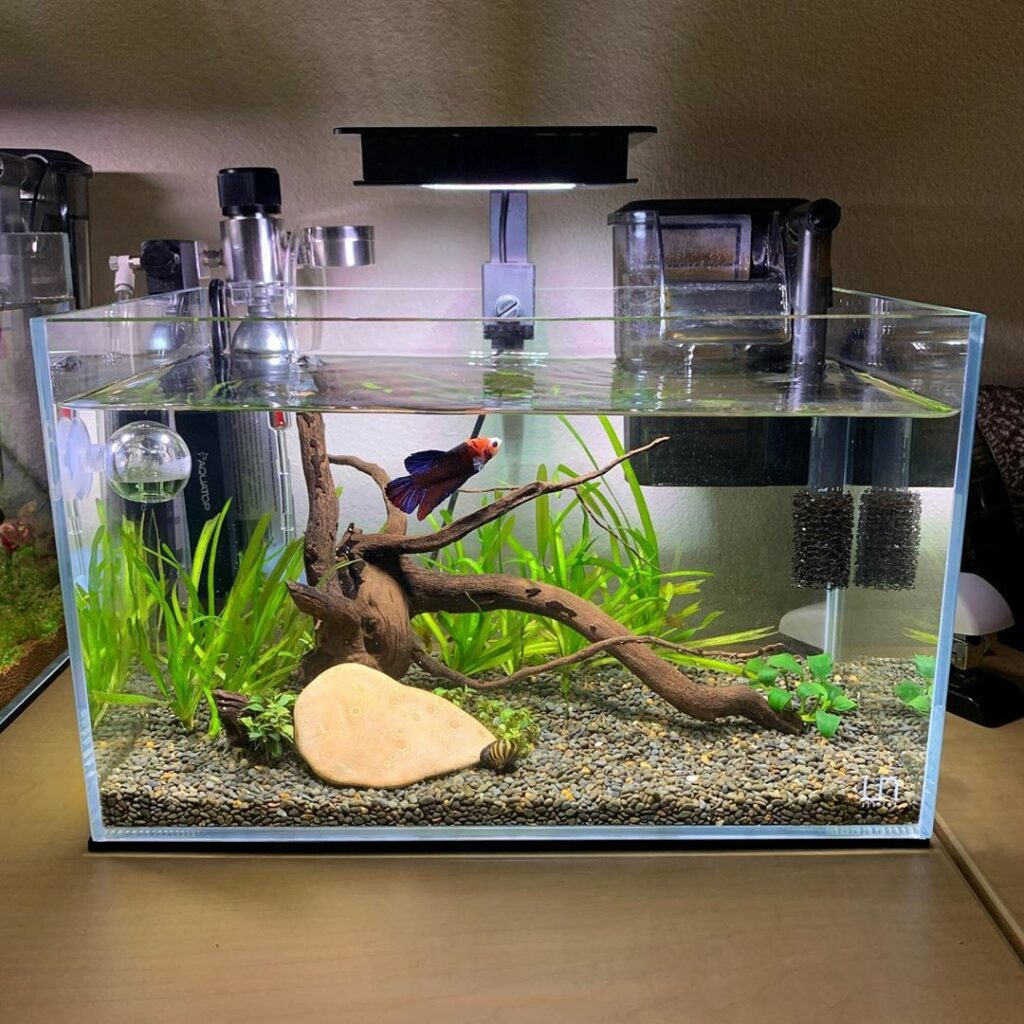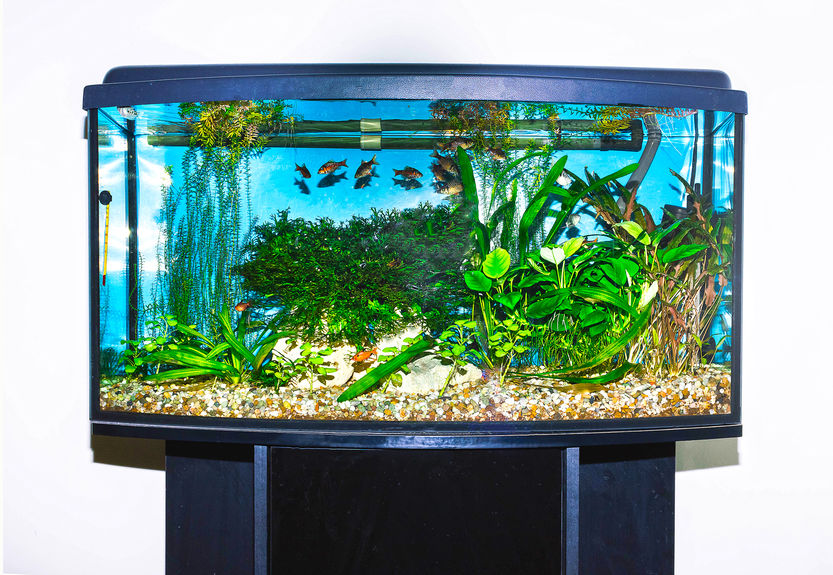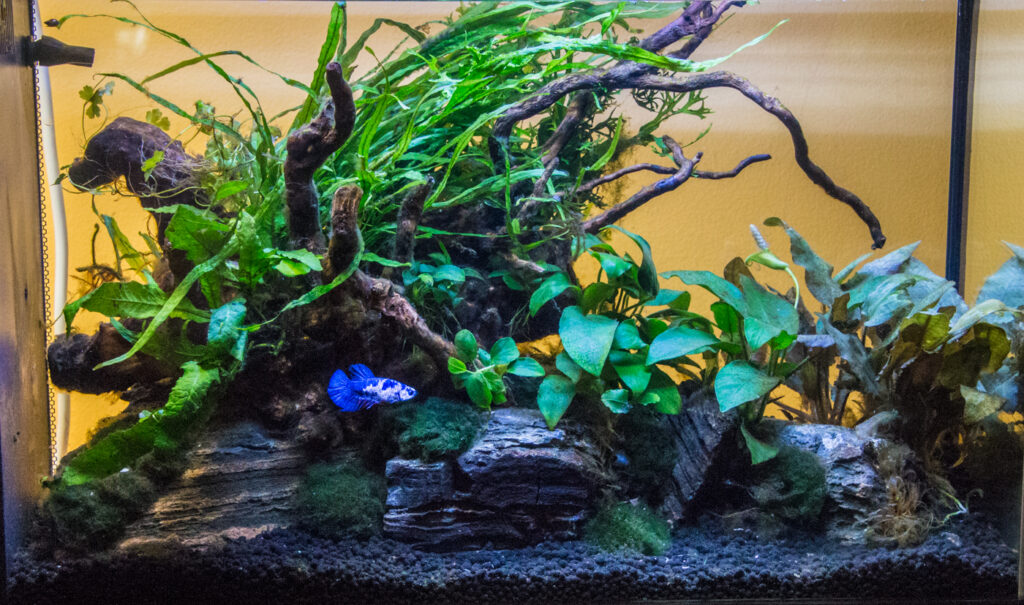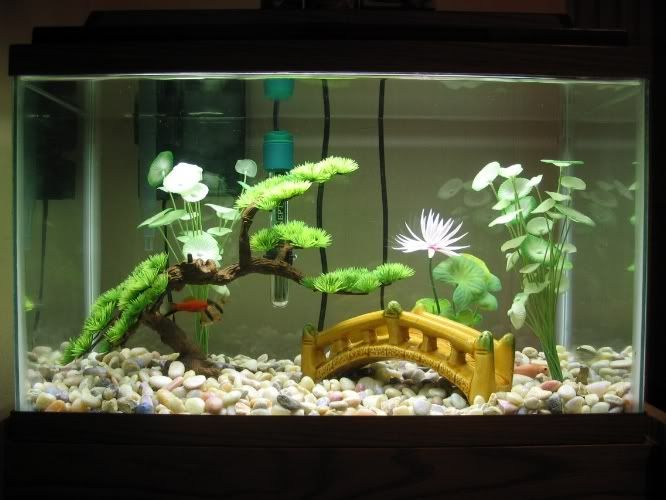Contents
How to Set up Your First Betta Fish Tank
Betta fish are beautiful and elegant with vibrant colors. These fish are also very beginner-friendly, so we can’t recommend them enough!
It can be tempting to purchase a Betta fish immediately, without reading about its care needs first. We get it. You’re impatient, and you think you can figure it all out on the way.
We advise you to take some time to read this article first, specifically designed to tell you how to set up your first betta fish tank. If you know how to do that, your Betta fish will hopefully be happy and live a healthy and long life.
Tank setups are essential, and a lot of people get it wrong for Betta fish. It’s easy, and you just need to follow three simple steps.
You can find these in our article, so you can just follow them and create the perfect environment for your beautiful Betta fish!
Step 1: Choosing Your Betta Fish Tank And Accessories
Before you choose your Betta fish, it’s important that you consider some essential aspects. Here, you can find everything to consider when you choose your Betta fish tank and accessories.

Picking your Betta’s tank: size matters!
Most people think that Betta fish are fine in a small bowl environment. Some even believe that plastic is fine.
We are here to set the record straight. Size absolutely matters when it comes to picking your Betta’s tank.
If you don’t want your Betta fish to fall sick, be unhappy and potentially have a shortened lifespan, you must pick the perfect tank for your fish. Don’t think that because Betta fish originally come from narrow streams that it’s ok to put them in small fish bowls.
These beautiful creatures surely deserve more than that!
The minimum tank size Betta fish should be put in is 5-gallons. Ideally, choose bigger. In the fish world, especially in the Betta fish world, bigger is better when it comes to tanks.
A 5-gallon tank is the minimum requirement to establish a Nitrogen cycle as easily as possible. While this is also possible in smaller-sized tanks, it takes much longer, and it can be a frustrating process.
This means you’re at a lower risk of inserting diseases or having bacteria, fungus or algae in your tank before you insert your beautiful Betta fish in.
Do Betta fish need a filter?
Now that you know what fish tank size to get, you might wonder if Betta fish need a filter in their tank. The answer is yes. They do need a filter, even if these fish are naturally used to still waters.
A filter has many advantages.
It keeps your tank clean, which saves you a lot of work and keeps your fish healthy and happy. It can even prevent illnesses, bacteria, fungus, and algae invasions from appearing in your aquarium. So what’s not to love?
You just have to be careful picking your tank filter and installing it. You need a gentle one, as Betta fish can’t swim in strong currents. It’s very difficult for them because of their long and beautiful flowing fins.
Some fish tanks come with filters, but it’s not the case for all of them. And you might want to change the filter if it’s too strong. You just need to get a filter with adjustable flow settings.
As for the technical details of the filter you should get for a Betta tank setup, the filter should have a GPH (Gallons Per Hour) four times greater than the size of your aquarium.
So if you want to get a 5-gallon tank, you need a filter that has at least 20 GPH, meaning it filters 20 gallons per hour.
It’s much easier than it sounds, we promise. It just depends on the size of your tank, and then you multiply it by four.
Do Betta fish need a heater?
Yes, Betta fish need a heater in their fish tank. That can sound a bit strange, but they are tropical fish and come from the tropical waters of Thailand. So they need the heat in order to survive and to be healthy.
You shouldn’t put a heater in your tank if it’s less than 5-gallons, but you shouldn’t keep your Betta fish in smaller tanks, as mentioned previously. So basically, if you respect the tank size for Bettas, you always need to insert a heater in it.
We advise you to get a fully submersible heater, specifically one that can keep the water temperature between 78 and 80 degrees Fahrenheit. Ideally, get a heater that comes with a thermostat.
You also need to monitor the tank’s temperature pretty often to make sure that the water conditions don’t change and to keep your Betta fish healthy. You should use a separate thermometer, as the ones attached to the heaters aren’t always the most accurate ones.
For example, if there’s a temperature drop and it’s too cold for Bettas, diseases like Ich can come into the tank and target your fish. If the temperature is too high, that actually speeds up the aging process of Bettas and drastically reduces their lifespan.
So monitor the temperature closely! Betta fish are easy to care for, but there are still some small things you need to look out for, and keeping the same tank conditions is essential to their well-being.

Getting your gravel
Gravel is essential for your Betta tank’s ecosystem. While Betta fish like to swim at all levels in an aquarium, they especially like to hang out at the bottom of the tank.
We advise you to either buy smooth or small gravel, so your fish doesn’t hurt itself when it’s hanging out at the bottom.
Just be careful that you don’t get gravel that has large rocks in it. Otherwise, food residue, fish waste, and other organic waste can get stuck in the gravel. This then degrades the quality of water and can introduce infections into the tank and infect your Betta fish.
If you want to add live plants to your Betta fish tank, you need to add around two inches of gravel so the plants can root. If you prefer to add fake plants to your tank, you only need one inch of gravel to your tank.
But you can check for the types of plants you want to add. It’s also important that they’re compatible with the tank population, which in this case is Betta fish.
Also, as we said earlier, gravel can be essential for the tank’s ecosystem. That’s because beneficial bacteria can grow on the surface and will help to break down any waste.
Plants and decorations for your Betta fish
Plants and decorations can really liven up your fish tank and can also be beneficial to your fish’s health and wellbeing.
Betta fish like to hide, to lounge on leaves, and to sleep in hidden places. So adding tanks and decorations will help satisfy all of these.
It’s good to reorganize the tank’s decorations every once in a while. You can do that when you clean the tank, for example, or perform water changes.
That’s because Betta fish can easily get bored or even depressed if they don’t explore and have the same surroundings. So keep things interesting for your Betta fish, and you’ll see how happy it will be!
Just be careful when you pick decorations and make sure that they’re safe for your Betta’s long and delicate fins. As for plants, you can’t use plastic ones with Bettas because of this same reason and use silk ones instead if you don’t want real live plants.
Of course, live plants are always better as they recreate your fish’s natural environment as well as clear up the water, and add oxygen to the fish tank.
Lighting for your Betta fish
If your fish tank doesn’t come with lighting, you should get lighting. It’s extremely important for fish, especially Betta fish.
Think of Betta fish like humans. They like to have light when they’re awake, and prefer darkness when they’re resting or sleeping. So we recommend you set a consistent lighting schedule to give your fish a sense of comfort and to keep it healthy.
LED lights are particularly useful when it comes to that, as you can choose and control the light intensity. You can even set some automatic timers, so you don’t have to change the lighting manually.
Step 2: How To Setup Your Betta’s Tank
This is the second step you should follow to recreate your Betta’s perfect environment, now that you know what tank and accessories to get.
Below, you can find every detail you need to follow to be able to set up your fish tank.
When you decide to get any type of fish, you need to set up your tank as close as possible to the fish’s natural environment. And Betta fish are no exception.
Betta fish originally come from small, slow-moving streams in Thailand, large puddles, and even rice paddies. All of these are shady spaces, where there are a lot of hiding spots.

Preparing and placing the aquarium
Once you purchase the ideal tank for Betta fish, you need to prepare it well and place it in the right spot.
First, you should clean the aquarium with some water. Don’t use any soap. As for placement, we recommend you place your empty Betta tank next to a window. Just be careful not to place it in direct sunlight, as too much light can deteriorate your Betta’s health.
Choose LED lights instead that come with a timer or you will have to automatically adjust throughout the day. Some tanks already come with these lights, as mentioned previously.
The surface where you place your aquarium should be sturdy, so it can’t fall. You can even buy a special stand for that, one that’s specifically designed to hold an aquarium’s weight.
If you have a cat, a dog, or any other type of pet, it’s best to leave your fish tank in a space your pet can’t access, or even a separate room, if that’s possible. It’s safer for everybody involved and makes you avoid a lot of trouble and tears.
When you place the empty fish tank on a surface, you also need to leave five inches between the wall and the tank, so you have enough space left for the tank’s filter.
Install your filter
After you find the perfect place for your fish tank, you should install your filter.
Unfortunately, all filters are different, so we can’t give you a definite method to install yours in particular.
Usually, the instructions manual and your supplier can help you more and give you advice on how to mount your specific tank filter. You can even find tutorials on Youtube, which can be easier to understand than written instructions. The internet is your friend!
Finally, remember not to turn on your filter before your tank is filled with water and has all of its components.
Add your gravel
You can now add the gravel of your choice. Ideally, pick one that doesn’t come with large rocks. Before you put it in the tank, rinse it under cool running tap water. Don’t use soap. Rinsing it allows you to remove dust that could get your tank dirty and clog your filters.
If you want to add live plants to your aquarium, add two inches of gravel. If you want fake silk ones, add one inch only.
Set up your plants and decorations
This is the fun part, where you get to pick which plants (real or fake) and decorations you want to add to your tank. Let your imagination run free! If you want to be able to watch your Betta fish, put higher plants at the back so they don’t block your view.
You just need to make sure that the decorations are anchored in the gravel and that you bury your plants’ roots.
Fill the tank up
After you have followed all these little steps, you can fill your tank. To do so, put a plate on top of the gravel and pour water on top of it until your aquarium is full. The plate prevents the gravel from moving. Remove it when you’re done.
When you fill the tank, make sure there are no leaks. Also, you shouldn’t fill it to the top. You should leave at least an inch and a half of space.
Betta fish are anabantoid, a complicated word that basically means they can breathe the same air as humans because they have an organ called the labyrinth.
It’s actually important that your Betta fish uses its labyrinth to stay healthy, so leaving a gap in your tank is essential. Also, Bettas like to jump, which is why it’s not good to fill your tank till the top.
Turn on your filter and install your heater
You can now turn on the filter and make sure that the water is circulating properly. You might have to adjust settings before you find the perfect ones.
You can then install the heater, which comes with suction cups so you can attach it to the tank. The temperature of the water should be between 78 and 80 degrees Fahrenheit. Get a thermometer where you can easily check on the water’s temperature.
Add neutralizer and perform a fishless cycle
Finally, you should add a neutralizer to your tank, especially if the tank’s water is tap water. The neutralizer will remove the water’s chlorine so that you can perform a fishless cycle.
If you don’t do that, your Betta fish will die. So in this natural fishless cycle, healthy bacteria develop and convert ammonia to nitrite and then nitrates. The first two are toxic, and the last one isn’t.
Cycling your tank usually takes four to eight weeks, but it’s really worth the wait. Afterward, you can introduce your fish to the aquarium.
Step 3: How to Introduce Your Betta To Its New Tank
This is the last step to follow to complete your perfect Betta fish tank setup. Now, you can introduce your fish to its new tank.
So here’s how to do it properly, to have a healthy and happy Betta fish swimming around!

Buying your Betta: how to choose a healthy Betta
When you buy a beautiful Betta fish, it’s essential you choose a healthy one. You don’t want all that tank setup work to be for nothing. Even if the seller tells you the fish is fine, there are still some things you should check to make sure of the Betta’s condition.
There are some signs to look out for to make sure your Betta is healthy. These include no fuzzy substances or white dots, as these can signal diseases. They also include no deformities such as in their fins, scales, or even eye deformities.
Here are positive signs that show a Betta fish is healthy: the fish is swimming normally and active, and the Betta is flaring at you or other Bettas. Another good sign is if the Betta fish has undamaged fins and a bright-colored body.
If these criteria are not met, and you see some warning signs, choose another Betta. If your seller doesn’t seem to carry any healthy ones, change sellers. Don’t get discouraged. There’s a healthy and beautiful Betta fish waiting for you somewhere!
Also, it’s very important that you don’t add Betta fish to your tank before it’s fully done with its cycle and is mature enough.
This way, you reduce the chance of any infections or bacteria coming in and infecting your fish. It also makes the transition smoother, as fish, in general, don’t like changing conditions and prefer steady water conditions.
Finally, introduce your Betta fish to its new tank
This last recommendation is pretty obvious, and it’s the one you’ve been waiting for all along!
After you meet all the tank requirements, after it’s set up and you choose a healthy Betta fish, you can finally introduce it to its new tank.
You can’t just pop your Betta fish into your fully cycled tank. You first need to acclimate your fish to its new environment. Otherwise, it can stress your Betta fish out, and it won’t be happy or survive long.
When you buy your perfect healthy Betta fish, it comes in a bag of its own water, which is different from the water that’s in your set-up tank.
So what you need to do to acclimate your new Betta fish to its new environment is to keep the bag closed and gently let it float on the top of the set-up tank.
You need to do this for about 20 minutes to an hour or until the bag reaches the same temperature as the Betta fish tank setup. You have to be patient, but it’s essential you take time to acclimate your fish to its new environment.
Once the bag’s temperature is the same as the tank’s water, you need to remove all the water from the bag, as it can’t mix with the other water. So either scoop your Betta fish out of its bag and add it to its tank or drain the bag’s water first and then add it.
And that’s it. You’ve successfully managed to create the perfect Betta fish tank setup and to add your fish to it!
Final Thoughts
To sum it up, it’s pretty easy to do a Betta fish tank setup. It can require some patience, but it’s definitely worth it.
If you create a safe and enjoyable space for your Betta fish that recreates the fish’s natural environment as much as possible.
First, you need to know what tank and accessories to pick. Then, you can set up your Betta’s tank. Finally, you can slowly introduce your healthy Betta fish to its new environment!
If you follow all these steps carefully, your fish will be healthy and happy.

Ian Sterling, founder of Fishlab.com, began his aquarium journey over 30 years ago, driven by a deep fascination for fish and their diverse personalities. His website, Fishlab.com, is dedicated to making fishkeeping accessible and enjoyable, offering beginner-friendly guidance, expert insights, and a community for aquarists to connect and share experiences.


